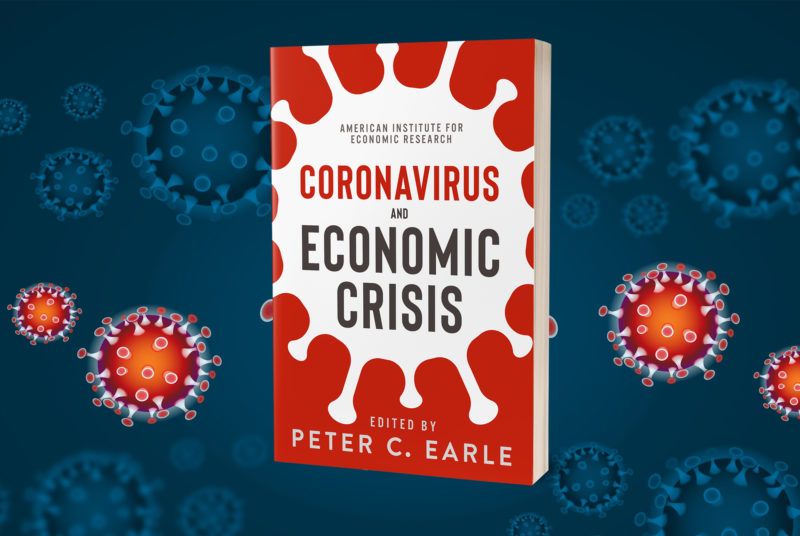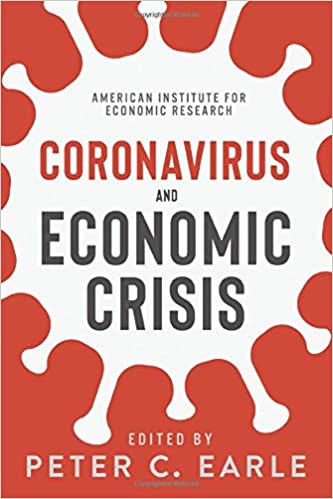Coronavirus and Economic Crisis: The First Draft of History

America today faces the most ominous threat to freedom as we’ve known in many generations. The reason and occasion: a pandemic disease. It and the policy response to it has changed fundamentally almost everything we used to take for granted: the right to earn a living, the right to travel, the right to associate, and even hope in the future itself. The calamity has been unparalleled, with social, economic, and political consequences yet unknown. All we really know is that nothing will be the same.
The American Institute for Economic Research has now produced a book on the topic, written by our researchers in real time as the crisis unfolded. You will be struck by its prescience, first page to last. The book is available now: Coronavirus and Economic Crisis.
The conventional wisdom, still coalescing as of this writing, is that the American coronavirus experience officially began on January 21, 2020; on that day, the US Centers for Disease Control and Prevention announced that the first domestic case had been discovered in Washington State.
For roughly five weeks, news of an escalating health crisis in Wuhan Province had been leaking out of China—much of it surreptitiously reported via anonymous social media accounts. It was not long before the inevitability of the disease’s spread became clear, and less than a week after the disease had reached the US, the American Institute for Economic Research’s first article on the uncoiling pandemic appeared, with many more to follow.
In those opening days of what soon became an international emergency of historic proportions, AIER’s researchers swung into action: devouring reports, discussing rapidly changing facts and political developments, analyzing historical precedents and new developments, and writing. We wrote, quite literally, around the clock—from late nights, to early mornings, to rushed and skipped meals. It was a ceaseless cycle of taking down each new report and idea, editing one another’s work, fact-checking, and often revising until moments before publication.
During that time, we noted that there was a desperate need for other voices besides the mainstream media, which flew into an overdrive state of panic. There needs to be an independent voice, but few others were writing about the virus, and certainly not about the probable (and later realized) policy responses, much less their likely financial, economic, and social impact. AIER stepped up.
The willingness to speak up early—and thus often alone, at least initially—speaks directly to the institutional DNA of the American Institute for Economic Research. We were founded in 1933 by a young, intellectually curious Army officer who felt duty-bound to respond to the growing academic capture in economic policy making, and in particular the politicization of monetary policy. His writings under the auspices of AIER, completely consistent with his commissioning oath, aroused the ire of higher-ups in the Roosevelt administration, resulting in investigations and threats by agents and officials in the War Department.
Clearly stated in our Articles of Association (1939), AIER exists
so that there may be more widespread understanding of the fundamental economic relationships affecting the citizens of the United States, both as individuals and as members of a complex economic society, with the ultimate object of advancing the welfare of the American people.
Closing in on ninety years later, the researchers and staff of AIER once again find ourselves in the midst of a rapidly evolving morass with few proponents of free markets by our side.
In the weeks after the virus began to spread within the United States, waves of fear-mongering and appeals to swift, heavy government intervention inundated the major news networks. By March 11, when the World Health Organization had officially classified the spread of the coronavirus a pandemic, a run on supermarkets had already begun. Over the next ten days, numerous allusions were made to World War II, and the president of the United States invoked the Defense Production Act. The stock market crashed for the first time in thirty-three years, experiencing its second-worst day in a century in a one-day decline more severe than either of the two days of the Crash of ’29.
Around the world, polities on six continents ranging from tiny municipalities to entire nations quarantined nearly one billion citizens, imposed curfews and travel bans, deployed their militaries, and crushed the private sector. (To date, South Korea and Singapore represent the lone recusants from that trend.)
And thus a mere forty days after the first case of COVID-19 was reported in the US, even before rates of transmission or recovery could be accurately calculated, plans were in motion for over $4 trillion in government stimulus and bailout packages. Central banks unleashed a torrent of programs, flooding the world economy with money. And even at this point, the American Institute for Economic Research was still nearly alone in bringing liberal ideas and analysis to bear on the unfolding calamity.
The contributions of every economist and thinker in the liberal tradition have been vindicated throughout what are likely only the beginnings of this disaster: Menger’s and Fetter’s work on the subjective theory of value, which informed both the actions of individuals who acquired goods in advance and the prices that were later offered by people desperate to acquire them. The warnings of Hayek with respect to the pretense of knowledge, and of Morgenstern regarding the questionable accuracy of statistics in the social sciences. Ludwig von Mises’ observation that government intervention always results in further interventions owing to the unintended consequences of the first round of tinkering. And our own E. C. Harwood’s encouragement to be bold in the defense of liberty along with his counsel that “for integrity, there is no substitute.”
This book chronicles AIER’s coverage of the opening phase of the world coronavirus outbreak, through the full onset of the crisis, with speculations on the future of wealth and liberty in light of both the virus and the political response.
It includes contributions by Vincent Geloso, Jeffrey Tucker, Bruce Yandle, Pete Earle, James L. Caton, Raymond C. Niles, Robert E. Wright, Joakim Book, John Tamny, Robert Hughes, Stephen Davies, Brett Dalton, Scott A. Burns, Edward Stringham, Art Carden, Adam Thierer, William J. Luther, Allen Mendenhall, Stephen C. Miller, Veronique de Rugy, Max Gulker, Richard M. Salsman, and Richard M. Ebeling.
It is 250 pages.
May this book serve as important documentation of what this country and the world can learn for the future.











